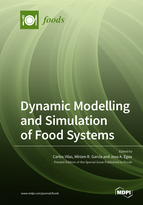Dynamic Modelling and Simulation of Food Systems
A special issue of Foods (ISSN 2304-8158). This special issue belongs to the section "Food Engineering and Technology".
Deadline for manuscript submissions: closed (30 June 2022) | Viewed by 32664
Special Issue Editors
Interests: mathematical modelling; advanced control; model-based optimization; food processes; food quality and safety; parameter estimation
Interests: predictive microbiology; modelling and optimization of food quality and safety; fresh fishery products; antimicrobial resistance; cleaning and disinfection; model identification; process engineering
Interests: modelling and optimization of agri-food processes; optimization in engineering and biotechnology; parameter estimation; optimal experimental design; data analysis; metaheuristics
Special Issues, Collections and Topics in MDPI journals
Special Issue Information
Dear Colleagues,
There are several factors that guide consumers’ choice of food products. Although price remains the main criterion, pleasure, convenience, and health are important driving factors of food market evolution. Food enterprises are making significant efforts to manufacture products that meet consumers’ demands without compromising safety standards. The food industry is also searching for means to improve the efficiency of the transformation and conservation processes by minimizing energy consumption, process duration, and waste generation. Food processes are very complex systems with highly non-linear dynamics and interactions among several time and spatial scales. Mathematical modeling and simulation are key elements that allow us to gain a deeper understanding of food processes and enable the use of tools such as optimization and real-time control to improve their efficiency.
This Special Issue aims to gather research developing dynamic mathematical models describing relevant factors of food processes. We invite authors to submit original research papers or comprehensive review papers related with the mathematical modeling of food processes from the perspectives of food safety (chemical or microbiological), food quality (organoleptic or nutritional), cleaning and disinfection, energy consumption, and resources waste. The Special Issue is not limited to model development, and we also welcome papers that use mathematical models to improve food processes. This includes decision-making tools, optimization, characterization of uncertainty/variability of model predictions, model simulation techniques, software sensors, and software development.
Dr. Carlos VilasGuest Editor
Dr. Míriam R. García
Dr. Jose A. Egea
Co-Guest Editors
Manuscript Submission Information
Manuscripts should be submitted online at www.mdpi.com by registering and logging in to this website. Once you are registered, click here to go to the submission form. Manuscripts can be submitted until the deadline. All submissions that pass pre-check are peer-reviewed. Accepted papers will be published continuously in the journal (as soon as accepted) and will be listed together on the special issue website. Research articles, review articles as well as short communications are invited. For planned papers, a title and short abstract (about 100 words) can be sent to the Editorial Office for announcement on this website.
Submitted manuscripts should not have been published previously, nor be under consideration for publication elsewhere (except conference proceedings papers). All manuscripts are thoroughly refereed through a single-blind peer-review process. A guide for authors and other relevant information for submission of manuscripts is available on the Instructions for Authors page. Foods is an international peer-reviewed open access semimonthly journal published by MDPI.
Please visit the Instructions for Authors page before submitting a manuscript. The Article Processing Charge (APC) for publication in this open access journal is 2900 CHF (Swiss Francs). Submitted papers should be well formatted and use good English. Authors may use MDPI's English editing service prior to publication or during author revisions.
Keywords
- dynamic modeling, simulation and optimization
- model identification
- software sensors
- process engineering
- predictive microbiology
- food quality and safety
- numerical methods
- food variability








